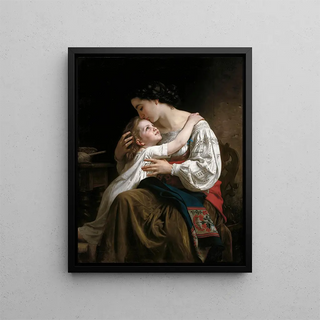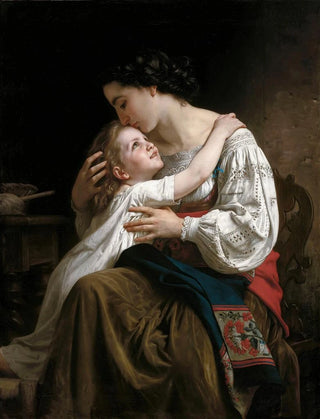Art print | The Sunrise - William Bouguereau


View from behind

Frame (optional)
In the fascinating universe of academic painting, "Le lever" by William Bouguereau stands as an iconic artwork, capturing the essence of harmony and beauty. This canvas, created at the end of the 19th century, evokes a moment of morning serenity, where the gentle light of dawn delicately embraces an idyllic landscape. Bouguereau, an undisputed master of realistic representation, manages to infuse this scene with a poetic atmosphere, inviting the viewer to immerse themselves in a world where nature and humanity coexist in perfect harmony. The art print of this piece allows for rediscovering the magic of Bouguereau's art, while offering a window into an era where aesthetics and emotion intertwined brilliantly.
Style and uniqueness of the work
Bouguereau's style is characterized by striking realism, impeccable technique, and meticulous attention to detail. "Le lever" perfectly illustrates these distinctive traits, where each brushstroke seems to breathe life. The light, omnipresent, plays a fundamental role in the composition, creating delicate shadows and reflections that animate the painting. The figures, often female, are depicted with sensuality and grace that testify to the artist's mastery. In this work, the beauty of the human body is celebrated, while being harmoniously integrated into a natural setting. Bouguereau succeeds in elevating the everyday to an almost divine level, transforming a simple sunrise scene into an ode to timeless beauty.
The artist and his influence
William Bouguereau, born in 1825, is often regarded as one of the greatest painters of his time. Raised in a rigorous artistic tradition, he managed to establish himself on the international art scene thanks to his exceptional talent and ability to capture the essence of humanity. His influence is undeniable, having trained many artists and inspired generations around the world. Bouguereau skillfully combined tradition and innovation, making his style a bridge between the past and the present. His works are often perceived as

Matte finish

View from behind

Frame (optional)
In the fascinating universe of academic painting, "Le lever" by William Bouguereau stands as an iconic artwork, capturing the essence of harmony and beauty. This canvas, created at the end of the 19th century, evokes a moment of morning serenity, where the gentle light of dawn delicately embraces an idyllic landscape. Bouguereau, an undisputed master of realistic representation, manages to infuse this scene with a poetic atmosphere, inviting the viewer to immerse themselves in a world where nature and humanity coexist in perfect harmony. The art print of this piece allows for rediscovering the magic of Bouguereau's art, while offering a window into an era where aesthetics and emotion intertwined brilliantly.
Style and uniqueness of the work
Bouguereau's style is characterized by striking realism, impeccable technique, and meticulous attention to detail. "Le lever" perfectly illustrates these distinctive traits, where each brushstroke seems to breathe life. The light, omnipresent, plays a fundamental role in the composition, creating delicate shadows and reflections that animate the painting. The figures, often female, are depicted with sensuality and grace that testify to the artist's mastery. In this work, the beauty of the human body is celebrated, while being harmoniously integrated into a natural setting. Bouguereau succeeds in elevating the everyday to an almost divine level, transforming a simple sunrise scene into an ode to timeless beauty.
The artist and his influence
William Bouguereau, born in 1825, is often regarded as one of the greatest painters of his time. Raised in a rigorous artistic tradition, he managed to establish himself on the international art scene thanks to his exceptional talent and ability to capture the essence of humanity. His influence is undeniable, having trained many artists and inspired generations around the world. Bouguereau skillfully combined tradition and innovation, making his style a bridge between the past and the present. His works are often perceived as






